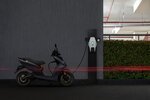Many riders ask this question; does the motorcycle battery charge while running? Well, it has to, otherwise, you will have to carry a battery while riding your motorbike. We do not do that hence, it means that the motorcycle battery does charge itself while riding.
Now suppose if your motorcycle batteries do not charge themselves while riding, riders would have to travel with adapters to keep it charged when it runs out of juice.
Modern motorbikes come with alternators just like the one that is there inside a car. Previous motorbikes had direct current generators in them. Older motorcycles had a starter motor so DC motors could function as a dynamo.
But how does a motorcycle battery charge while running? We are about to find out all about it in this post.
How Does Motorcycle Battery Charge While Running?

Just like a car battery, motorcycle battery charge while running, also. But the physical traits of a car and a motorbike are entirely different. Still, there are some similarities between a car and a motorcycle and their wire coils and magnets.
The magnets and coils remain still in one and spin in the other. This princess produced alternating current. Moreover, another similarity between a motorbike and a car is that both systems feature a rectifier or a regulator.
This regulator is attached remotely somewhere. Whereas the alternator in the car has this regulator. The wire coils and magnet produce alternating current, and the rectifier converts the direct current in the battery the bike uses while riding. So this regulator can determine the constant current level that your motorcycle receives.
On the other hand, the alternator of a car has this rectifier and a belt drives it. This regulator device is much bigger inside the cars and it pains through mechanical measures including a belt, not a shaft.
However, a motorcycle engine has magnets and wire coils that are also called stators, and one of them spins with the help of a crankshaft. The regulator or rectifier you will find here sits around the cooling air steam to calm the temperature down.
Components Involved in a Motorbike Charging System
Motorbike charging systems consist of a stator, battery, alternator, and rectifier. These modern charging systems have become so reliable that most riders do not know anything about them because most of them don’t have to fiddle with these systems, especially compared to their predecessors.
But it is always a good thing to understand how these components work. For example, the charging system consists of three major components, and your battery stores electrical energy for use while acting as a buffer for your bike’s electrical system.
The alternator is there to produce alternating current to operate the bike and charge the battery. The rectifier changes the alternating current to convert it into the direct current, storing it in the battery. It also regulates the amount of battery produced to prevent overcharging.
You can also consider the wiring that ties these components together. You might also find a couple of fuses and a relay in some systems. There is an additional margin of reliability with these components that enables you to add some electrical accessories without putting too much load on the system.
Motorcycle battery

The primary job of these components is to start the bike and supply any additional current that it needs when the alternator output goes down. It will only happen at low RPM when there is a high demand for current and the alternator is on the lower side.
For example, this is when you are stuck in slow traffic or are cruising at a slow speed. Moreover, multiple high-draw electrical resources exacerbate the entire scenario. For example, they might cause the battery voltage to dip down where it cannot start the engine.
Therefore, you will have to monitor the battery charge. This battery also works as a buffer between the charging system and the associated electrical components.
Alternators can put out some high voltages up to (75V alternating currents). But the battery puts reins on the alternator, and it prevents it from running away. So even if the rectifier fails, it might sacrifice itself in this process.
Moreover, this battery also protects sensitive components from getting damaged when the circuit is switched off or on when normal voltage spikes.
Motorcycle alternators

There are two types of mechanical devices used to produce electric energy. Direct current generators were popular on motorbikes back in the 1960s. However, modern accessories have electric starters.
Modern motorbikes use alternating current generators, which are also called alternators. These devices produce alternating currents. Since DC units are no longer used, therefore, we will discuss these alternators only.
There are different variations available on the theme. All motorbike alternators boil down to 2 types. The lesser common type is the automotive one. It goes externally and has a one-piece alternator.

Automotive alternator
Everything mandatory to paradise the current is present in this one unit. A small chain or a gear runs this type of alternator. Therefore, you can gear it up and down to get the correct rotational speed and output.
These are the most powerful alternator types, and they also create a lot of heat. This is why they are present outside. These alternators are mostly available on large touring bikes where plenty of current capacity is necessary.
Three-piece alternator
The second type is the 3-piece alternator. The three pieces here are a rectifier, a stator, and a rotor. Again, these components work in conjunction, but they are all stand-alone units.
The rotor
The rotor here is a small wheel that is there on one end of the crankshaft. Based on the alternator type, this rotor might feature small magnets within it and a field coil. Even a small amount of current can energize this coil to form a strong electromagnet. The latter types are called exciting field coils alternators, and they have brush/brushless styles.
The stator
It is a series of iron poles made of laminated bars and has copper wires wounded around. Each pole-wire assembly is called a coil, and they can range from one to a dozen or more on a stator based on how much output is necessary.
The rotor may be the external type based on the design, and the magnets revolve right around the stator. Or it can be internal types which means magnets revolve inside the stator. Both these types perform in the same way.
How Does the Charging System Work?

Following are the steps that are there in the charging process of your motorbike.
- When you turn on the key or press the starter button, the current starts flowing from the battery to various components. It includes the starter motor, the ignition system, and the fuel-injection system.
- Some current is used from the batteries when you start the engine, and a drain is identified by low idle or electrical accessories. But it is never going to spin the alternator fast enough to recharge in a warm-up.
- When you start riding the motorbike, and it picks up more RPM, the alternator output increases. A current is conducted through the wiring harness to the rectifier.
- It reaches the regulator in alternating current, and it passes through one to six diodes based on the system type or its capacity.
- These diodes are electrical doors, and they only allow current to move in one particular direction. Therefore, only a positive voltage will reach your bike’s battery and its electrical equipment.
- You can control the alternator using a thyristor with a voltage circuit sensor to regulate direct current voltage.
- When this direct current hits a predetermined level of 14.5 volts, the sensing circuit will cause the thyristor to turn the switch on.
- When it makes the connection, it connects the stator coil to the ground. As a result, it kills the alternator output.
- The thyristor turns back on as soon as a voltage drops around 13V to 13.5V, and the alternator starts picking up.
Now you might be thinking that this entire process must take time, and you are right about it. However, under normal circumstances, this entire cycle occurs a thousand times per second. Therefore, a powerful and fast semiconductor is useful. Therefore, mechanical regulators are not a regular sight in modern motorbikes.
FAQs
How long does a motorcycle need to run to start charging the battery?
Motorcycles charge their battery while the engine is idle. This recharge time relies heavily on the current state of your battery. However, if you have a good battery, that will take around 12 to 18 minutes even when your bike is neutral, your alternator and regulator are still running, and they will keep your battery charged.
How does a battery charge in a motorbike?
The charging system of a motorbike contains three major components. There is a stator, an alternator, and a rectifier. Your battery stores the electric energy, and it acts as a buffer for the electrical system of your motorbike.
The alternator creates the alternating current to run the bike and charge the battery while the rectifier converts it into direct current. This system has to work several times per second. Therefore, a semiconductor is there to speed up the process.
Will a motorbike battery charge while idling?
Yes, it will charge in this state. As long as the alternator’s mechanical action is occurring and the engine crankshaft is turning it, the alternator will keep producing alternating current, and your bike’s battery will continue to charge while idling.
How long will it take to charge a 12-volt motorbike battery?
It will take around 4 hours to 24 hours, depending upon the current status of your battery. To see if the charging princess is complete, you will need a voltmeter to charge the better once in a while.
Final Word
So, does motorcycle battery charge while running? Yes, of course, it can continue to charge while running or idling. It has to do that; otherwise, you will have to carry a charging adapter with you all the time.
How does a motorcycle battery charge while running or while idling is much speedier these days? It is because modern bikes come with semiconductors in them to make the entire process smooth and fast. Therefore, mechanical regulators are becoming less trendy because they make this entire process much slower.

